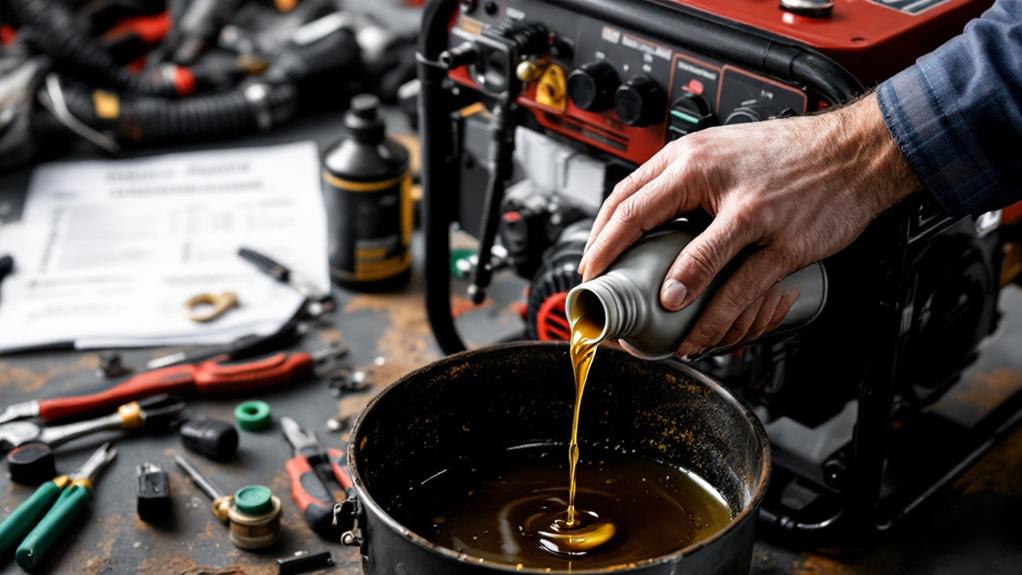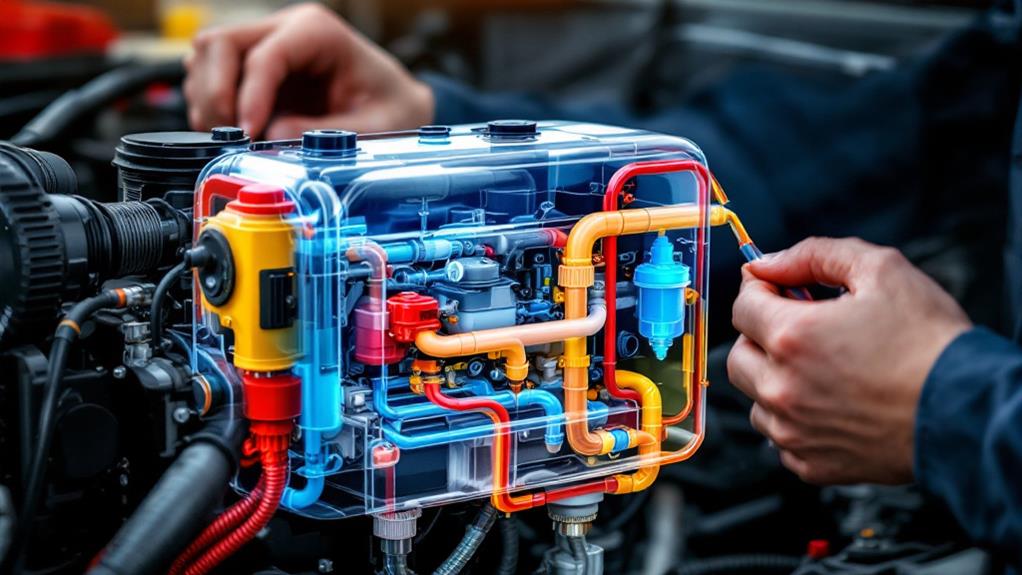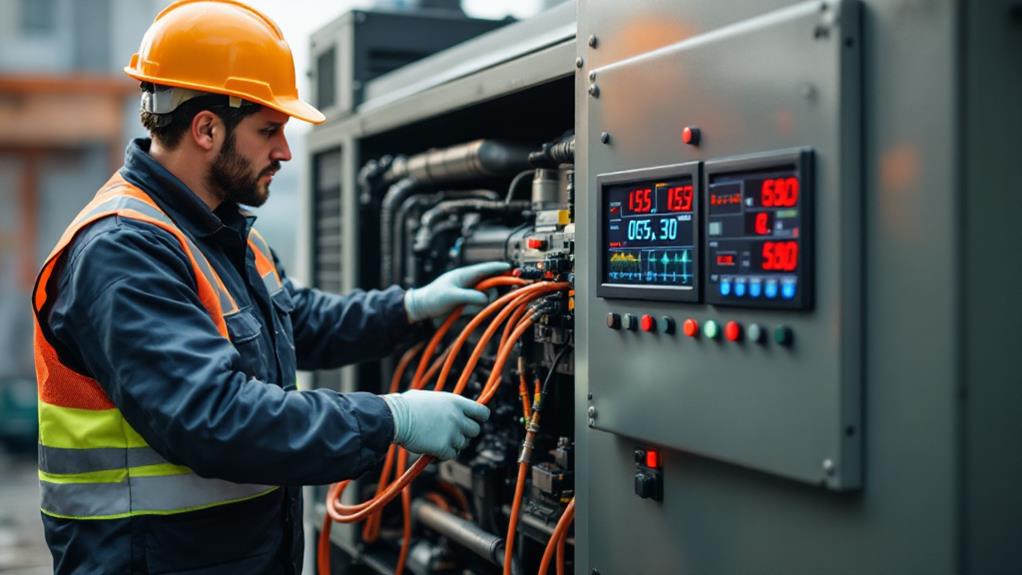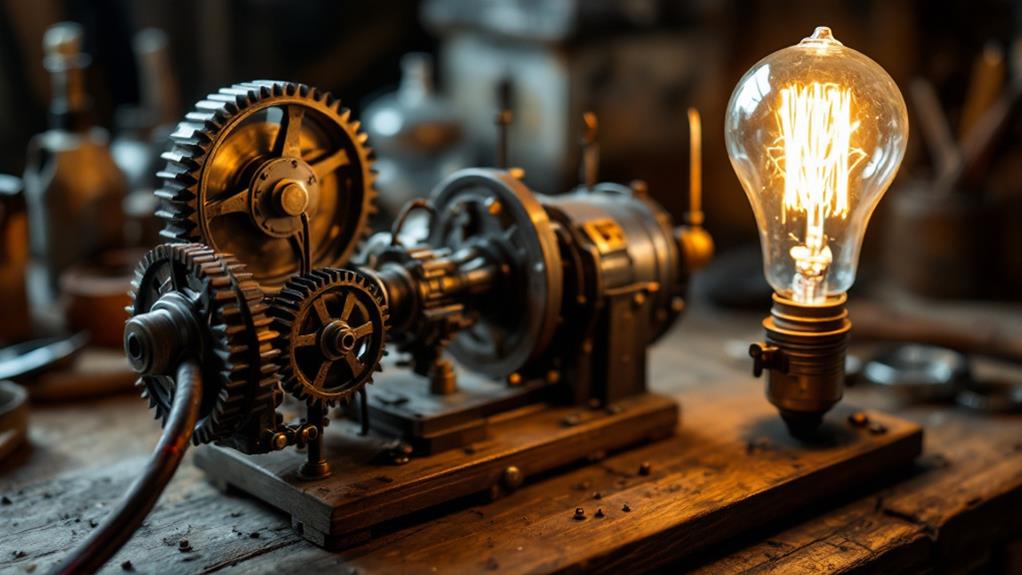Essential Tips for Generator Oil Changes and Maintenance

To keep your generator in top shape, prioritize regular oil changes and maintenance. Use the right oil type for your generator and climate, changing it every 50-200 hours or annually. Perform proper oil change procedures, including draining old oil completely and refilling with the correct amount. Don't forget to check and replace filters, inspect fuel and coolant systems, and maintain the battery. Consider professional load bank testing and maintenance for peak performance. Keep detailed records of all services and parts replaced. By following these essential tips, you'll guarantee your generator's reliability when you need it most.
Understanding Generator Oil Types
When it comes to generator maintenance, understanding oil types is indispensable for ideal performance. You'll need to choose the right oil for your specific generator model and operating conditions. Most generators use either conventional mineral oil or synthetic oil, each with its own benefits.
Mineral oil is more affordable and suitable for generators used infrequently. Synthetic oil, while pricier, offers better protection and performance, especially in extreme temperatures. It's optimal for generators that run frequently or in harsh environments.
Oil quality considerations are vital. Look for oils with API (American Petroleum Institute) ratings that match your generator's requirements. Higher-quality oils contain additives that enhance engine protection and longevity.
Don't forget about seasonal oil changes. In colder climates, you might need a lower-viscosity oil for easier winter starts. Conversely, hotter environments may require a higher-viscosity oil to maintain proper lubrication.
Always consult your generator's manual for specific oil recommendations. Regular oil changes and using the correct type will vastly extend your generator's lifespan and ensure reliable operation when you need it most.
Frequency of Oil Changes
Consistency is key when it comes to generator oil changes. You'll need to establish a regular schedule to guarantee your generator runs smoothly and efficiently. Most manufacturers recommend changing the oil after the first 20-30 hours of use for new generators, then every 50-200 hours of operation or annually, whichever comes first.
However, these oil change intervals can vary depending on factors such as generator usage, environmental conditions, and the type of oil used. If you're operating your generator in dusty or extreme temperature environments, you may need to change the oil more frequently. Always refer to your generator's manual for specific recommendations.
To maintain proper oil viscosity, it's vital to use the right type of oil for your generator and climate. Check the oil level regularly, ideally before each use, and top up as needed. Don't forget to inspect the oil for any signs of contamination or discoloration, which could indicate internal issues. By adhering to a consistent oil change schedule and using the correct oil, you'll extend your generator's lifespan and guarantee reliable performance when you need it most.
Proper Oil Change Procedure

Performing a proper oil change on your generator is essential for its longevity and performance. To begin, make sure your generator is turned off and cooled down. Locate the oil drain plug and place a container underneath to catch the old oil. Remove the plug and allow the oil to drain completely, which may take several minutes.
Once drained, replace the plug securely. Next, find the oil fill cap and remove it. Using a funnel, pour in the manufacturer-recommended type and amount of oil. Be certain to use proper oil draining methods and adhere to correct oil fill levels to avoid overfilling, which can damage your generator.
After adding the oil, replace the fill cap and run the generator for a few minutes to circulate the new oil. Turn it off, wait a moment, then check the oil level using the dipstick. Add more if necessary to reach the full mark. Finally, dispose of the old oil responsibly at a recycling center. Regular oil changes using this procedure will help maintain your generator's efficiency and extend its lifespan.
Checking and Replacing Filters
Regular oil changes aren't the only maintenance task for your generator. You'll also need to focus on checking and replacing filters to guarantee supreme performance. Start by inspecting air filters regularly, as they're indispensable for preventing debris from entering the engine. A clogged air filter can reduce efficiency and potentially damage internal components. Replace the air filter when it appears dirty or according to the manufacturer's recommendations.
Don't forget about the oil filter, which plays a pivotal role in monitoring oil condition and keeping contaminants out of the engine. Change the oil filter during each oil change to maintain clean, effective lubrication. Some generators also have fuel filters that require periodic replacement to prevent fuel system issues.
When checking filters, look for signs of wear, damage, or excessive dirt buildup. If you're unsure about the condition of a filter, it's better to replace it than risk potential engine damage. Keep a log of filter replacements to stay on top of maintenance schedules. By diligently checking and replacing filters, you'll extend your generator's lifespan and ensure it's ready when you need it most.
Inspecting Fuel and Coolant Systems

Beyond oil and filters, your generator's fuel and coolant systems require regular inspection to guarantee peak performance. Start by checking the fuel lines for any signs of wear, cracks, or leaks. Verify the fuel tank is free from contamination and filled to the appropriate level. Don't forget to inspect the fuel filter for clogs or debris.
For the coolant system, begin by monitoring coolant temperatures to detect any irregularities. Check the coolant level and top it off if necessary, using the manufacturer's recommended coolant type. Inspect hoses and connections for leaks or damage, and look for any signs of corrosion in the radiator.
To maintain optimal generator performance:
- Regularly analyze exhaust emissions to identify potential engine issues
- Clean or replace the air intake system components as needed
- Test the thermostat to ensure proper temperature regulation
- Inspect the water pump for signs of wear or leaks
Battery Maintenance and Testing
The lifeblood of your generator's starting system lies in its battery. To guarantee your generator starts reliably when needed, you'll need to perform regular battery maintenance and testing. Start by checking the battery's connections, confirming they're tight and free from corrosion. Clean any corrosion with a mixture of baking soda and water, then rinse and dry thoroughly.
Next, test the battery's voltage using a multimeter. A fully charged 12-volt battery should read between 12.6 and 12.8 volts. If it's below 12.4 volts, recharge it immediately. Monitor battery charging levels regularly, especially after extended use or long periods of inactivity. If your battery consistently fails to hold a charge, it may be time for replacement.
Most manufacturers provide battery replacement recommendations based on age or usage. Generally, you should replace your generator's battery every 2-3 years, or sooner if you notice decreased performance. When replacing, choose a battery that matches your generator's specifications for voltage, capacity, and size. Proper battery maintenance and timely replacement will help certify your generator starts reliably when you need it most.
Load Bank Testing

While battery maintenance focuses on starting reliability, load bank testing verifies your generator can handle its rated capacity. This indispensable test simulates real-world conditions by applying electrical loads to your generator, making certain it can perform under stress.
When conducting a load bank test, you'll gradually increase the electrical load to match your generator's full capacity. The test typically lasts for several hours, allowing you to assess your generator's performance over time. Load bank capacity and duration are key factors in determining the effectiveness of your test.
Here's why load bank testing is essential:
- It identifies potential issues before they become critical failures
- It helps maintain manufacturer warranties
- It ensures your generator can handle peak demand during emergencies
- It extends the life of your generator by preventing wet stacking
To perform a load bank test, you'll need specialized equipment and proficiency. Consider hiring a professional technician to conduct the test annually or bi-annually, depending on your generator's usage and local regulations. By regularly performing load bank tests, you'll have peace of mind knowing your generator is ready to perform when you need it most.
Scheduling Professional Maintenance
After addressing critical maintenance tasks yourself, it's crucial to schedule regular professional maintenance for your generator. While you can handle many routine checks and oil changes, certified technicians have the proficiency to perform more complex inspections and repairs. They'll guarantee your generator operates at peak efficiency and catch potential issues before they become major problems.
Set up a maintenance schedule based on your generator's manufacturer recommendations and usage patterns. Typically, you'll want professional servicing at least once a year or after a certain number of operating hours. Use scheduling pointers on your phone or computer to keep track of upcoming appointments.
Proper record keeping is indispensable for monitoring your generator's health over time. Maintain a log of all professional maintenance visits, including dates, services performed, and any parts replaced. This information will help technicians identify patterns and make informed decisions about your generator's care. It's also valuable for warranty purposes and if you ever decide to sell your generator. By staying on top of professional maintenance, you'll extend your generator's lifespan and ensure it's ready when you need it most.



